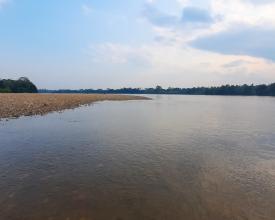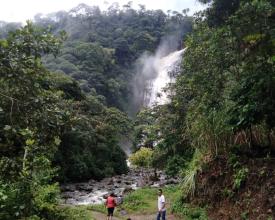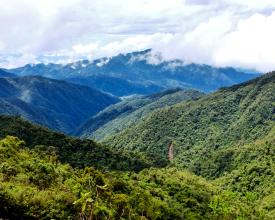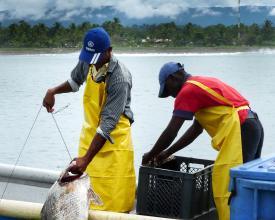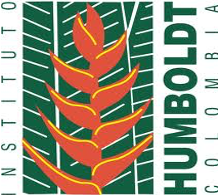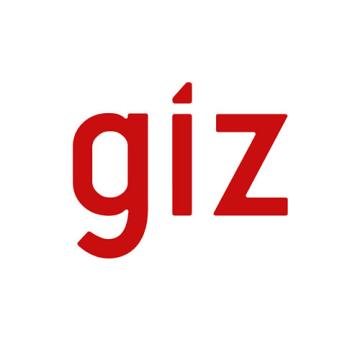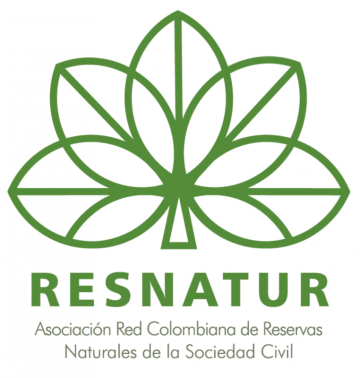
Beyond protected areas: recognition of OECMs in Colombia
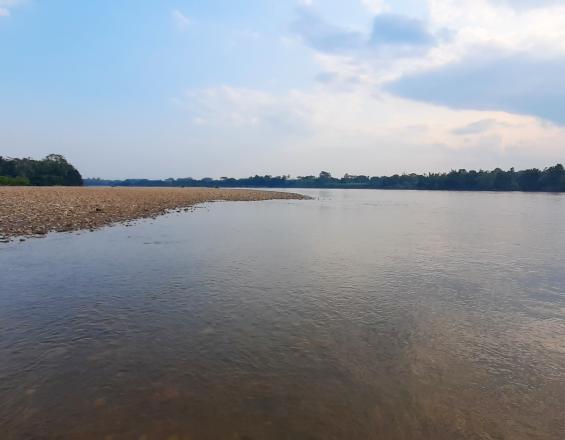
Colombia has implemented diverse conservation strategies. Some of these strategies have a legal basis, while others may be brought together as de facto conservation areas.
In this context, four workshops were held within Colombian regions, and 27 cases were evaluated as 'potential OECMs' (June 1019 to August 2021). The implementing team developed a questionnaire to gather the required and essential information of each case and assessed if they comply with the OECM definition and the four main criteria. Subsequently, 8 of the 27 cases were selected for further work (strengthening plans) to enhance the elements they need to meet the OECM definition and criteria.
Furthermore, a national procedure was co-designed and approved by the Ministry of Environment to enable the reporting of OECMs to the World Database on OECMs.
Context
Challenges addressed
The main challenges are that OECM will need to be acknowledged and included as part of planning or policy, and that the National procedure to report Colombian OECMs to WCMC works adequately.
Location
Process
Summary of the process
The two building blocks interact completly. In order to report to WCMC database, it is necesary to identify the potencial OECM area, to apply the criteria. We adapted a participative methodology that defined a series of questions for each criterion and its components according to the Colombian context, that make possible to analyze the consistency of the area with the OECM criteria. According to this verificatión, it is possible to report to WCMC.
Building Blocks
Identification and sthrength of OECM in Colombia
For the last 60 years, a great number of rightsholders in Colombia have promoted sustainable management and biodiversity conservation of their territories beyond protected areas, even though their conservation efforts have not been recognized as important elements of climate-smart land planning and have very little governmental support.
The project’s overarching goal is to strengthen and make visible the culturally rich and socially diverse conservation and sustainable production initiatives that different Colombian actors are implementing, as a contribution to sustainable development that does not impoverish the country's natural patrimony.
As their identification as Other Effective Area-Based Conservation Measures (OECM) is an opportunity to visualize those efforts, Resnatur and partners have been working for several years in adapting the OECM identification criteria to the Colombian context together with 27 initiatives, according to the international framework.
This project contributes to the implementation in Colombia of the Convention on Biological Diversity’s Decision 14/8 of 2018 that “Encourages Parties and invites others, in collaboration with indigenous peoples and local communities, to apply … …advice on OECMs”; … “Identifying OECMs and their diverse options within their jurisdiction;”
Enabling factors
- The adaptation of the international framework and especially the OECM criteria of the IUCN guidelines and the Decision 14/8 of 2018 to the Colombian context.
- The application of OECM criteria on a case by case basis.
- The development of two methodological processes to apply the OECM criteria and to identify the elements to be strengthened.
Lesson learned
• OECM framework allows to recognize other forms of conservation and governance.
• Capacity building is needed to apply the OECM criteria in a bigger scale.
• National authorities should be involved in the discussion on how to apply the criteria.
• More resources will be needed to identify OECMs and to monitor the biodiversity outcomes.
• OECMs must be areas maintaining high biodiversity value. There is a necessity to develop participative monitoring methodologies.
• OECMs are an oportunity to increase connectivity, effectiveness and climate change adaptation of protected areas systems.
• OECMs are key elements to Post 2020 Biodiversity framework goals.
The National Route for reporting OECM to WCMC
The project team has worked with the Ministry of Environment to construct and implement the National Route for reporting OECM and submitting to WCMC. This route was designed by the Ministry of Environment, as CBD focal point for Colombia, GEF Small Grants Programme in Colombia and the project. It is structured to guarantee the validation of each potential OECM by the government (Ministry of Environment), civil society (an NGO such as Fundación Natura) and Humboldt Institute linked to the Ministry with the scientific support necessary. These three entities comprise the Coordinator Group of the route. External evaluators and regional authorities will participate in the validation. It includes the individual assessment of each potential OECM by three verifiers who work independently from one another and send their evaluation to the Coordinator Group that establishes a consensual agreement on whether or not the area complies with OECM criteria and can be submitted by the Ministry to be included in WCMC data base. The project has also carried out capacity building of national verifiers, which will evaluate if potential OECM meet the criteria.
Enabling factors
Colombia has not reported the existing OECM to WCMC data base. One of the main achievements of the project is that two OECM cases have already been approved through the National Route and the Ministry will be sending in the short time the requirements for the WCMC verification process.
Moreover, this project contributes to the implementation in Colombia of the CBD Decision 14/8 of 2018: “Submitting data on OECMs to the UNEP’s World Conservation Monitoring Centre for inclusion in the World Database on Protected Areas”.
Lesson learned
The joint effort to construct and implement the National Route, that is easy to apply, enhances the social appropiation of the OECM and the interest of rightholders and skateholders to report to WCMC.
It is important to highlight that the National Route was designed and constructed through a joint effort between multiple stakeholders.
The National Report represents an important step in the formal recognition of biodiversity conservation, beyond protected areas, in Colombia. It contributes to the international commitments acquired by Colombia, such as the CDB, the Sustainable Development Goals (SDGs), the climate change adaptation goals and the Post 2020 framework, among others.
Resources
Impacts
The implementation of the OECM definition and criteria through the project is a practical exercise that has led, in each case, to a reflective analysis about the area’s management by the local stakeholders, in this case conducted at the regional workshops. As it was carried out on a case-by-case basis, in-depth analysis of issues and sharing of experiences with other participants with similar challenges has been shown to enrich their vision and perspectives and to generate even more ownership of their areas.
At national and regional levels, OECMs are included in the post-2020 Global Biodiversity Framework and Colombia has developed a Climate Adaptation National Plan. This project has enabled engagement with and capacity development about OECMs of regional environmental authorities, the Ministry of Environment and other governmental and non-governmental conservation and climate change stakeholders.
As Colombia is one of the first Latin American countries to implement the OECM criteria, we now have the capacity and opportunity to share experiences with other countries with similar socioeconomic contexts and contribute to the global discussions that is enriching in situ conservation perspectives.
Beneficiaries
8 community organizations and local governments in several Colombian regions that have set aside areas of their territories. 120 people have acquired capacity to apply OECM criteria and conduct the OECM national verification.
Sustainable Development Goals
Story
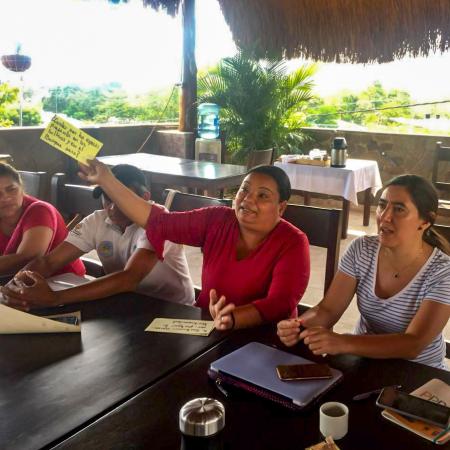
Beneficiary 1. Association of United Women of San Isidro (Amusi)
Since 2014, the Association of United Women of San Isidro (Amusi) protects and manages the six properties that constitute the Salto Topacio conservation-production area, which has 30 ha of dry forest and important water sources. The area is immersed in a matrix of agroforestry crops (76 ha). Through the cultivation of yams, the association seeks to vindicate the rights of women to work, so that they can make their own decisions, in a context of violence and displacement accentuated at the beginning of this century. The validation of the criteria clearly showed the issues that require strengthening. In this case, the protection of the water resource is urgent, since it is essential for the well-being of the San Isidro community. The prioritized actions were directed towards good practices in the management of water and ecosystems, and the strengthening of governance for a more participatory and inclusive management.
Beneficiary 2. the Andakí Municipal Natural Park
The Andakí Municipal Park (MNP) is in the municipality of Belén de los Andaquíes in the Colombian Amazon region, which has been conserving strategic areas for over 20 years in order to maintain their biodiversity. This conservation process actively involves local actors and has included the creation of nine municipal natural parks, including the Andakí MNP. The Andakí MNP covers an area of 26.7 km2 and was recognised by the local government based on its biodiversity, its ecosystem services and its important contributions to municipal development, as well as its role in maintaining sites of historical and cultural significance.
Andakí MNP was considered as a potential OECM because in Colombia local governments are not able to declare or manage protected areas. However, more than 140 local governments carry out ecological heritage and conservation actions to guarantee the supply of ecosystem services as part of their territories’ sustainable development, and one type of local government action has been the creation and management of municipal conservation areas. Although these areas are not recognised in the National System of Protected Areas of Colombia, they have a strong social function and in some cases are incorporated into land-use planning processes.
